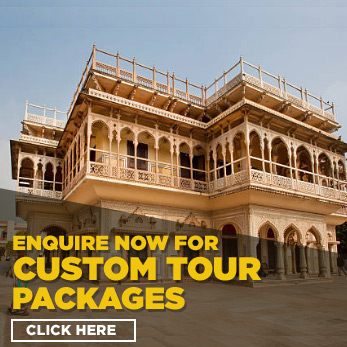Jaisalmer, the "The Golden city", is a city in the Indian state of Rajasthan, located 575 kilometres (357 mi) west of the state capital Jaipur. Once known as Jaisalmer state it is a World Heritage Site. The town stands on a ridge of yellowish sandstone, and is crowned by the ancient Jaisalmer Fort. This fort contains a royal palace and several ornate Jain temples. Many of the houses and temples of both the fort, and of the town below, are built of finely sculptured sandstone. The town lies in the heart of the Thar Desert (the Great Indian Desert).
The city’s most prominent landmark is the Jaisalmer Fort, also called Sonar Qila (Golden Fort). Unlike most other forts in India, Jaisalmer Fort is not just a tourist attraction. It houses shops, hotels and ancient havelis (homes) where generations continue to live.
Jaisalmer traces its inception to the 12th century. History tells us of Rawal Jaisal, the eldest heir of the Rawal of Deoraj, was passed over for the throne of Lodurva and a younger half-brother was crowned king. Rawal Jaisal went looking for a new location to set up his capital when he came across sage Eesul. The sage told him about Krishna’s prophecy which said that a descendant of his Yaduvanshi clan would found a new kingdom at this same spot. It was in 1156 that Rawal Jaisal constructed a mud fort, named it Jaisalmer after himself and declared it his capital.
Tourist Places to Visit in Jaisalmer
Jaisalmer Fort
The Jaisalmer Fort also goes by the name Sonar Quila (Golden Fort) as it rises from the desert itself and seems to become one with the golden hues of the sand. The setting sun adds its own magic and shrouds the fort with mystique. The fort is constructed in the classic style of the royals by local craftsmen. This fort is a world heritage site and forms an important plot point in one of Satyajit Ray’s famous Feluda stories and corresponding movie, Sonar Kela (The Golden Fortress).
Gadisar Lake
Gadisar Lake was constructed in the 14th century by Maharawal Gadsi Singh to meet the water needs of his arid lands. Considering its importance, many small temples and shrines were constructed around it, transforming it into a pilgrimage centre and a tourist attraction.
Jain Temples
The Jain Temples of Jaisalmer are a cluster of temples dating back to the 12th and 15th century. The temples, dedicated to two Jain Tirthankars (hermits) – Rikhabdevji and Shambhavdevji – are popular pilgrimage destinations. As is characteristic of any structure in Jaisalmer, these temples too, are built of yellow sandstone. The Dilwara style of architecture is borrowed from the famous Dilwara Temples at Mount Abu, a hill station popular among tourists and pilgrims. The walls of the ancient temples are beautifully decorated with intricate carvings. One can sit quietly within the complex and feel at peace. One can also visit the Gyan Bhandar Library. Students of comparative archaeology, or anyone else looking for knowledge, will delight in browsing through some of the rare manuscripts preserved here.
Jaisalmer Government Museum
Established by the Department of Archaeology and Museums, it is a prime attraction for tourists visiting Jaisalmer. The most striking display is the trophy of Rajasthan‘s state bird Godawan (the great Indian bustard). Traditional household items, rock-cut crockery, jewellery and statues from the 7th and 9th century AD displayed here are remnants of the city’s rich cultural heritage.
Nathmal Ji ki Haveli
Two architect brothers built Nathmal Ji Ki Haveli in the 19th century. They worked on the haveli from two sides and the outcome is a beautiful blend of the symmetrical construction. Miniature style paintings and mighty tuskers carved out of yellow sandstone are used for decoration.
Salim Singh Ki Haveli
This haveli was built in the first half of the 18th century and a part of it is still occupied by descendants of the original residents. The high arched roof is supported by carved brackets designed in the shape of peacocks. Legend has it that there were two additional wooden storeys that made it match the Maharaja's palace in height, but he ordered for the upper level to be demolished.
Patwon Ki Haveli
Among the largest and the most elaborately carved havelis in Jaisalmer, this five-storey structure sits proudly in a narrow street. While the haveli has lost some of its early glory, a few paintings and mirror work art can still be seen on the inside walls.
How to Reach Jaisalmer
By Air: The closest airport is Jodhpur airport which is 284 kms away.
By Road: Jaisalmer is connected to Jodhpur, Bikaner and Jaipur by bus and taxi.
By Train: There is a direct train service between Jaisalmer and Delhi, with a few trains connecting the two cities.
Jaisalmer Images
- 5N-6D Golden Triangle Tour Package
- Golden Triangle Tour with Bharatpur
- Golden Triangle Tour with Golden Temple
- Golden Triangle Tour with Jaisalmer
- Golden Triangle Tour with Jodhpur
- Golden Triangle Tour with Jodhpur and Jaisalmer
- Golden Triangle Tour with Mandawa
- Golden Triangle Tour with Neemrana
- Golden Triangle Tour with Nimaj and Udaipur
- Golden Triangle Tour with Pushkar
- Golden Triangle Tour with Ranthambore
- Golden Triangle Tour with Royal Rajasthan
- Golden Triangle Tour with Udaipur
- Golden Triangle Tour with Varanasi





